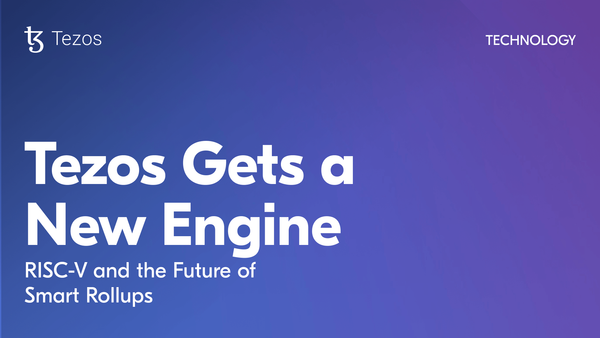Tezos Gets a New Engine: RISC-V and the Future of Smart Rollups
Why Tezos is expanding its toolkit with RISC-V, and what it means for developers, rollups, and users.
650 words, 4 minute read

Imagine your favorite electric car quietly installing a second motor, not because the first one was bad, but because it wants more power, more flexibility, and room to grow. That’s what Tezos is doing with its smart rollups. The new engine? It’s called RISC-V.
It won’t replace the current engine (WebAssembly or WASM). Instead, it joins the toolkit. For builders and users alike, it opens the door to faster, cheaper, more powerful applications.
What Is RISC-V? #

So, what is RISC-V? Pronounced “risk five,” it’s a low-level computer instruction set — a kind of foundational language that processors understand directly. If high-level programming languages like Python or JavaScript are how developers express ideas, RISC-V is the raw machine vocabulary used to carry those ideas out step by step.
A useful way to think about it: imagine building a machine from scratch. Most languages give you pre-assembled tools. RISC-V gives you the individual components, the screws, gears, and wires, to build exactly what you need, nothing more. It’s minimal by design, easy to inspect, and highly customizable. There’s no clutter, no extra weight, just raw, versatile parts designed to be assembled your way.
Unlike older instruction sets like x86 or ARM, RISC-V is open-source, minimal, and modular. That makes it easy to customize, audit, and extend. It’s becoming a big deal in the world of chip design and embedded systems, and now, it’s making its way into the blockchain space.
Why Add RISC-V to Tezos? #

WebAssembly (WASM) has powered Tezos rollups from the beginning. It’s portable, widely supported, and great for many use cases. But it has limits. It wasn’t designed for advanced functionality like runtime code generation or ultra-precise proof systems.
That’s where RISC-V comes in. It’s not replacing WASM, just offering another engine under the hood. Think of it like this: WASM is a Swiss Army knife. RISC-V is a custom-built power tool.
Because it’s simpler and lower-level, RISC-V makes it easier to generate and verify fraud proofs, keep precise track of gas usage at the virtual machine level, run complex compiled code efficiently, and even support just-in-time (JIT) compilation techniques.
All of this makes it especially well-suited for Tezos rollups, which are built around verifiable computation. Developers will benefit from better tooling and deeper system access, and users can expect faster, cheaper apps.
What Can You Expect? #

RISC-V has been on the Tezos roadmap for quite a long time now. The first time I heard about it was at a TezDev 2024 presentation. Engineers have already built a fully compliant interpreter in Rust, tested it thoroughly, and begun integrating it into the rollup infrastructure. While others are just beginning to explore RISC-V (Vitalik Buterin proposed it as a future VM option for Ethereum in May 2025), Tezos is already deep into implementation.
If you’re a Tezos user, you obviously won’t need to change a thing. WASM rollups will continue to run just fine. But as RISC-V support rolls out (likely within this year), rollups may choose it for performance and flexibility. That means rollups can be more efficient, flexible, and easier to maintain, improvements that might not be visible to end users or dApp developers, but that strengthens the foundation Tezos dApps are built on.
For developers, it’s a big win: fewer limitations, better tooling, and more options for building the kinds of apps they want.
Tezos Keeps Quietly Leveling Up #

No hype machines. No noisy drama. Just carefully chosen upgrades that improve performance, security, and flexibility for the long haul.
If you want to dive deeper into how RISC-V is being implemented in Tezos, check out this Tezos X-plained episode. It’s 17 minutes long, and it includes all the information I shared in this article and more.
RISC-V is another example of how Tezos makes the right engineering decisions before they become trendy. It’s not about chasing headlines, it’s about building the future.